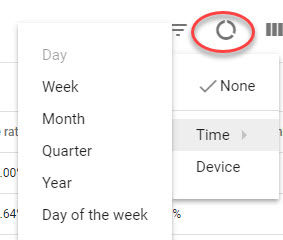People have a natural tendency to care about what others are doing around them as a means of validating themselves.
This is true in our personal lives when the Joneses come home with a new sports car, but also in paid search when brands want to outrank their competitors.
In our personal lives, it does not often do us much good to compare to others, but in business, it is more important to be aware so that you can take advantage of opportunities.
In paid search, Google has given advertisers a great tool to help understand how your brand’s ads compare to your competition: the Auction Insights report in Google AdWords. The data can be pulled for both search and shopping campaigns.
Let’s take a look at some of the data it can provide, and how you can use it.
How to pull the Auction Insights Report
Select whatever level of data you want to review across campaigns, ad groups, or keywords. You can pull this data for one specific group or across multiple. Once you select the keywords you want, the Auction Insights report option pops up as shown below. Select this option and you are on your way.
What data is available in the Auction Insights Report?
There are 6 data points you can see inside this report. They are:
- Impression Share: The percentage of times your brand’s ad shows up in the auction
- Average Position: The average rank of that ad
- Overlap Rate: How often another advertiser’s ad received an impression in the same auction that your ad also received an impression
- Position Above Rate: how often another advertiser’s ad in the same auction shows in a higher position than your own, when both of your ads were shown at the same time
- Top of Page Rate: How often your ad (or the ad of another advertiser, depending on which row you’re viewing) was shown at the top of the page in search results
- Outranking Share: How often your ad ranked higher in the auction than another advertiser’s ad, or if your ad showed when theirs did not.
These data points can then be cut by time, as well as device by clicking the circle graph icon.
How can this data be used?
Estimating a competitor’s budget
I know this point isn’t exact given quality score, bidding strategy, etc., but it is directionally correct. If you know your impression share is 50% and another competitor’s is 75%, you can estimate they are spending 50% more than you.
Understanding strategy at the device level
One of the big things brands are struggling with is how to value mobile traffic, especially since most transactions still occur offline or when they do happen online via desktop. You can use the device-level cut of data to understand how your competitor’s brand is performing on mobile.
For example, in the below example you can see the difference between this competitor’s performance on desktop and mobile. On desktop our brands compete very often, and we rarely outrank this brand. However, on mobile we compete significantly less often and outrank the competitor brand much more frequently.
You can therefore infer that our mobile strategy differs and our brand values the mobile channel more by bidding more aggressively.
Trending over time
Your brand may have an influx in budget, or see a change in performance. As you make your own strategy decisions, it is valuable to see how this impacts your competition. For example, below you can see this competitor hardly ranking in the first week, but over the course of a few weeks their impression share triples and our overlap rate does as well.
However, as they participate in more auctions they have reduced their average rank, essentially wanting more traffic, but at a reduced rate given the lower position.
Conclusion
Over time, Google has continued to make more data available to help advertisers get smarter about their business. I think this is one of the best attempts yet, with so much direct data where competitors are identified by name.
With this data, you can really help benchmark your own performance. The one warning I would give to everyone, however, is to not overreact based on your competitors. You can’t manage your business purely based on what someone else is doing.
However, having a reference point for what is happening around you can only help to make you a smarter paid search marketer.
source https://searchenginewatch.com/2017/11/07/adwords-auction-insights-report-a-key-to-understanding-the-competition/





No comments:
Post a Comment